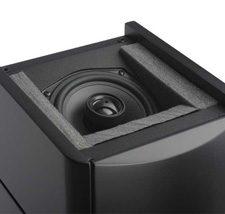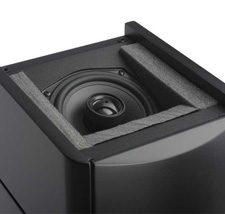

 The major contribution that Dolby Atmos and other object-based surround formats adds to the home theater experience is the ability to encode and play back height information. Previous 5.1 and 7.1 surround formats utilize speakers on the same plane as the listener, so you hear sounds in front, to the sides, and in back of you. With Atmos material, though, you get a chance to experience sounds above you, making home theater a truly 3D audio experience. One way to achieve playback for the height channels is to install in-ceiling speakers. A second option is the Dolby Atmos-enabled module, which is a speaker with drivers aimed to direct sound toward the ceiling so that it can be reflected back down toward the listening position. These can either be built into traditional speakers, like with some of the new Pioneer Elite speakers, or they can be separate modules like the Atlantic Technology 44-DA speakers being reviewed here.
The major contribution that Dolby Atmos and other object-based surround formats adds to the home theater experience is the ability to encode and play back height information. Previous 5.1 and 7.1 surround formats utilize speakers on the same plane as the listener, so you hear sounds in front, to the sides, and in back of you. With Atmos material, though, you get a chance to experience sounds above you, making home theater a truly 3D audio experience. One way to achieve playback for the height channels is to install in-ceiling speakers. A second option is the Dolby Atmos-enabled module, which is a speaker with drivers aimed to direct sound toward the ceiling so that it can be reflected back down toward the listening position. These can either be built into traditional speakers, like with some of the new Pioneer Elite speakers, or they can be separate modules like the Atlantic Technology 44-DA speakers being reviewed here.
The advantage for separate Atmos-enabled modules is that you don't have to buy a brand new floorstanding speaker pair if you like what you have and just want to add Atmos capability to your current system. Weighing in at seven pounds, the 44-DA is a fairly small speaker that you can easily carry around with one hand. The speaker retails for $499 per pair, and it features a one-inch tweeter and 5.25-inch woofer set in a concentric driver array. It's important to note that these are among the biggest woofers used in an Atmos-enabled speaker right now, and I also like that Atlantic Technology uses separate drivers for the tweeter and midrange instead of a single full-range driver. Atlantic Technology lists a frequency response down to 150 Hz with an attached +/-3dB rating.
I placed the front pair on top of a flat ledge on my Salk Soundscape speakers and the back pair on top of my B&W CM6 S2 speakers. The binding posts are set in a small recessed area in the back of the speaker, and they didn't accept my usual banana plug connectors. Pressing down on a small spring-loaded knob exposes a small opening through which to thread bare wire. Technically, other types of connectors could be accepted, but the opening is rather small and directed downward where, because of the small space it is set in, maneuvering could be a little tight for some connectors depending on the design. I hooked the 44-DA speakers to the Yamaha RX-A3040 Dolby Atmos-capable receiver that I had on hand for review.
With upconverted 5.1-channel material like standard Dolby Digital movie soundtracks, the 44-DAs were able to convey a strong sense of a taller image with a very accurate location of where sounds are from a height perspective in scenes that depict taller spaces. Clarity suffered a little, which had more to do with the ability of the Yamaha's processing to upconvert source material that's not natively encoded for Dolby Atmos.
I also tested native Dolby Atmos material, first using various tracks on the Dolby Atmos demo disc and then movies such as Teenage Mutant Ninja Turtles (Blu-ray, Paramount). The degree of clarity and the accuracy with which the 44-DAs were able to convey the three-dimensional size and shape and location of sounds within an image were nothing short of amazing. With four height-channel speakers in place, panning effects for overhead sound were masterfully presented, as exemplified in various battle scenes in Teenage Mutant Ninja Turtles where objects were launched overhead and you could accurately hear the arced path being taken.
While the 44-DA speakers had no problems pressurizing my room with sound when needed, there were a few instances where I could still hear a difference in output between my very large floorstanding Salks and the smaller Atlantic Techs. The significance of this is that the 44-DAs, while fine performers in their own right, are not a perfect match for my own speaker complement, and any reader considering adding Atmos modules should listen for yourself to determine whether they are the ideal match with your own speakers.
 High Points
High Points
• The DA-44 allows for accurate imaging with Dolby Atmos content.
• The module has decent bass response and good frequency response across a wide bandwidth.
• The separate tweeter and midrange drivers make for strong, smooth output.
Low Points
• The module may be difficult to match with very large speakers, in terms of sound output.
• The binding-post design limits flexibility with connectors.
Comparison and Competition
With Dolby Atmos still in its infancy, there are currently few competitors in this market for Atmos-enabled up-firing speakers modules. KEF's R50 module also uses a one-inch tweeter and 5.25-inch woofer in KEF's Uni-Q array but carries a significantly higher price tag of $1,200/pair. The Onkyo SKH-410 retails for $249/pair, with street prices that are even lower. The Onkyo features a single, much smaller driver for all frequencies and will likely not be able to deliver the same even soundfield in a larger room, especially at reference volumes. The Definitive Technology A60 module is priced the same as the 44-DA; but, like the Onkyo, it also sports a single, smaller driver, so output and matching to bigger floorstanders could be a problem. Its binding posts appear to be of a more flexible design, set on a flat back-panel surface. Of course, if you have the space and ability to install in-ceiling speakers, then there are a lot of additional choices for you.
Conclusion
If you want to equip your system for Dolby Atmos playback, you'll need to decide for yourself whether in-ceiling speakers or Atmos-enabled speakers are right for you. Cost, space, décor, the size of your room, and the other speakers in your system that you need to match with are all factors that should be carefully considered. I still hope that, as the adoption of Dolby Atmos continues to accelerate, more manufacturers will put out options in the market so that there are more choices to find the ideal Atmos module to match each system. That being said, Atlantic Technology has done a wonderful job creating what is probably one of the strongest-performing offerings for a standalone Dolby Atmos-enabled module speaker on the market today. At nearly $1,000 for a full complement of four, it's certainly not the cheapest option; but, if you do not want to mount speakers above you and you do not wish to replace your existing front-channel speakers, the 44-DA is a great way to go for accurate, room-filling height information in a small, relatively unobtrusive, and easy-to-place package.
Additional Resources
• Check out our Bookshelf and Small Speakers category page for similar reviews.
• Atlantic Tech's New In-Ceiling Speakers are Ideal for Atmos/AURO at HomeTheaterReview.com.
• Dolby Atmos at Home: The Known Knowns and the Known Unknowns at HomeTheaterReview.com.
2015-05-29 03:06:27
Would the volume disparity difference be different if you used all speakers from Atlantic technology? The problem kind of sounds like the same problem you have in a recording studio when you switch speakers to monitor a mix.